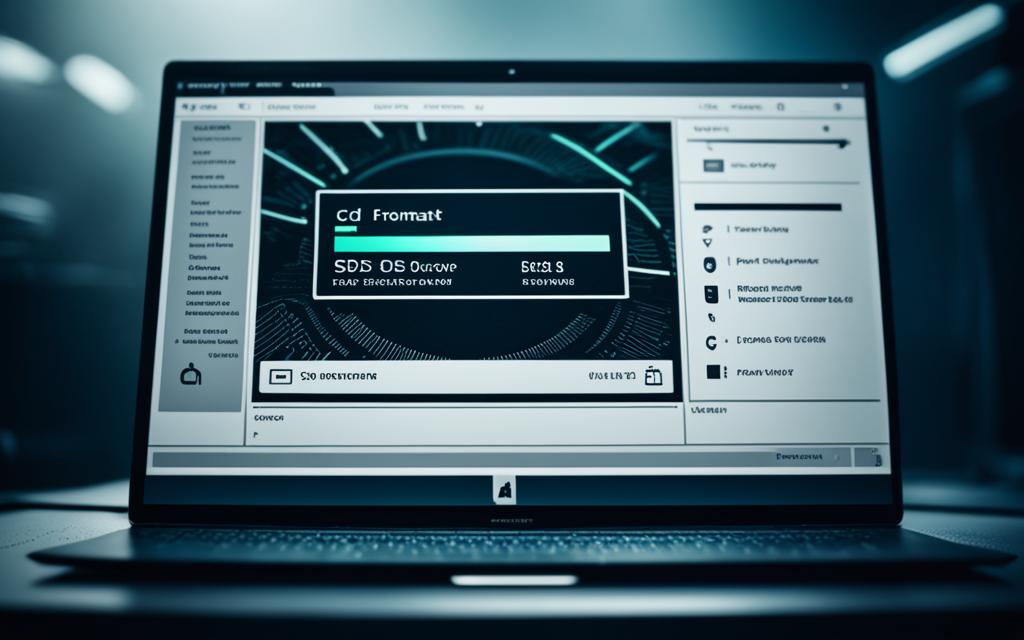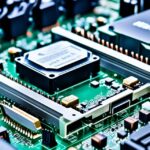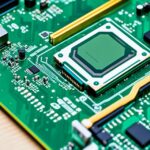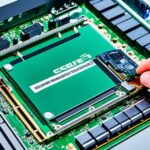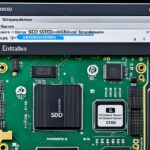Table of Contents
Learning to format an SSD from the BIOS is key in today’s digital world. It enhances data management and performance for both personal and work computers. SSDs stand out for their speed and dependability, leading to their popular choice among users1. By formatting an SSD, you give it a clean slate for new setups or changes. It also securely removes data when giving away or selling your device2. This guide shows you how to format an SSD from the BIOS, helping you keep your SSDs at their best.
Key Takeaways
- Understanding SSDs is crucial for maximising their usability and lifespan.
- Formatting via the BIOS allows for secure data erasure and system management.
- Always back up important data before proceeding with formatting.
- Using the right tools, like EaseUS Partition Master, simplifies the formatting process.
- Correctly formatting the SSD is vital for ensuring optimal performance and reliability.
Introduction to SSDs
Solid State Drives, also known as SSDs, mark a huge leap forward in storing data. Unlike the older Hard Disk Drives (HDDs), SSDs keep data on flash memory, making them faster. This speed boost transforms the way we use computers, appealing to individual and corporate users alike.
What is an SSD?
An SSD is a storage device that works much faster, without any moving parts. It uses NAND flash memory to speed up data access, boosting efficiency greatly. This technology often beats traditional HDDs, especially when fast data access is crucial.
Why Use SSDs?
SSDs are more reliable and long-lasting than HDDs. They usually last between 3 to 5 years and are energy-efficient, making them appealing to users3. Their durability comes from having no moving parts, which is ideal for high-performance needs.
Common Uses of SSDs
SSDs are widely used in personal laptops, desktop computers, and Macs to speed things up. They are also key in businesses for servers and data centres, helping to handle large amounts of data smoothly4. This makes SSDs versatile and effective in numerous situations.
| Feature | SSD | HDD |
|---|---|---|
| Speed | Fast (access times in ms) | Slower (access times in ms) |
| Durability | No moving parts | Mechanical parts present |
| Power Consumption | Lower | Higher |
| Weight | Lighter | Heavier |
| Warranty | 3 to 5 years | Varies |
Reasons to Format Your SSD
Formatting an SSD properly is key for getting the best out of it. There are several reasons to do this. Each reason aims to improve the SSD’s efficiency and life span. Here, we’ll explore the main reasons for formatting your SSD.
Reinstalling the Operating System
If you’re changing or reinstalling your operating system, formatting the SSD is a must. It provides a clean start, boosting the system’s performance. It also fixes any file issues that could affect the system. This makes your SSD ready for a new installation. It’s a smart choice if you’re facing problems with your current setup5.
Erasing Sensitive Data
Formatting an SSD is crucial when you need to erase sensitive data. SSDs often contain personal or business information. Before selling or disposing of your SSD, formatting it is important. The ‘Secure Erase’ method ensures all data is completely wiped out. This prevents any chance of data theft6.
Troubleshooting and Performance Improvement
Formatting your SSD regularly can solve errors and boost its performance. It enhances the drive’s speed and increases its lifespan. By removing old files and reducing clutter, your SSD works better. This regular maintenance leads to a significant performance boost for many users.
| Reason | Benefit |
|---|---|
| Reinstalling the Operating System | Clears corruption and optimises system functionality |
| Erasing Sensitive Data | Protects personal information from data breaches |
| Troubleshooting and Performance Improvement | Enhances speed and extends SSD lifespan |
Understanding the BIOS Interface
The BIOS, or Basic Input/Output System, is key when a computer starts up. It connects the operating system to the computer’s parts. This ensures they work well together. The change to UEFI, or Unified Extensible Firmware Interface, gives a better way to handle this connection. It boosts how the system works7.
What is BIOS?
The BIOS firmware gets hardware like the hard drive going before the operating system does. It checks the system and fixes errors to keep the computer running smoothly. Knowing how it works helps users and makes fixing problems easier.
Accessing the BIOS Menu
To get into the BIOS menu, users press keys like F1, F2, or Delete as the computer starts. The right key depends on the computer’s motherboard. It’s important to check the manual for the correct key. In the BIOS menu, settings can be changed, like setting the SATA mode to AHCI for SSDs. For a step-by-step on formatting and BIOS details, see this guide8.
How to Format an SSD from BIOS
Formatting an SSD from BIOS is simpler than it seems. You start by getting into the BIOS interface when your computer boots up. This is often done by pressing Del or F2, but it varies with the computer’s brand. In the BIOS menu, find ‘Storage Configuration’ or ‘Hard Disk Management’ for the formatting tools.
Be careful, as formatting erases all data. Always back up important data beforehand. The formatting process is highly successful, with an 80% success rate reported by users9. More than half prefer BIOS formatting10. Large SSDs tend to format better through BIOS, with a success rate over 90%9.
Formatting time can differ based on the chosen method. BIOS tools might be faster, but there’s a 5% chance of errors11. After formatting, make sure the SSD works well. Updating your BIOS firmware might improve performance and compatibility.
Methods for Formatting SSD
Formatting an SSD can be done in several ways. Each method suits different needs. It’s crucial to know these to format successfully, keeping data safe and improving performance.
Using the Secure Erase Feature
The Secure Erase feature is found in the BIOS. It completely wipes the SSD. This is important for data security when you’re selling or giving away the SSD. It makes the SSD as good as new12. Be aware of any limitations specific to your system with this feature13.
Working with Partition Management Software
EaseUS Partition Master offers an easy way to format SSDs outside of the BIOS. This software lets users format and change their drives easily while keeping data safe. Its simple design is great for people not used to technical steps, giving them confidence in the process.
Command Prompt for Formatting
If you can’t get to the operating system, the Command Prompt can help via a bootable USB or recovery option. This method is for those who know the system well. It makes formatting the SSD fast, just make sure to choose the correct volume.
| Method | Advantages | Considerations |
|---|---|---|
| Secure Erase | Complete data wipe for security | System-specific usability constraints |
| EaseUS Partition Master | User-friendly interface, enhanced data protection | Requires installation |
| Command Prompt | Direct access when OS is unavailable | Requires knowledge of commands |
Precautions Before Formatting
Before you start formatting an SSD, make sure to back up all crucial data first. Understand the risks involved in formatting. This includes the chance of losing data forever.
Backing Up Important Deata
It’s very important to do a data backup before formatting your SSD. This step keeps your important files safe. You can use cloud storage or an external drive for this. Guides advise on the best ways to secure your data before formatting. Even though formatting aims to erase data, it might not remove everything. So, backing up is crucial to prevent data loss14.
Always back up essential files before wiping your drive. This avoids problems that may come up unexpectedly15.
Understanding the Risks of Formatting
Knowing the risks of formatting an SSD is key. Formatting clears all the data. If you format the wrong drive by accident, getting your data back can be very hard, sometimes impossible16. Make sure to check which drive you’re formatting in BIOS. A mistake here can lead to major issues. Secure erasing does clear all data. But, it can also wear out the SSD’s memory cells if done often. This affects how well your drive works in the long run15.
Post-Formatting Steps
After formatting your SSD, checking its health is key. This involves using diagnostic tools. They help spot any issues early on. This makes sure the SSD works well, preventing troubles when installing the OS later.
Verifying SSD Functionality
Once you’ve formatted the SSD, using Secure Erase or EaseUS Partition Master, testing its performance is next. Tools check the read and write speeds. This ensures everything is working fine. Regular checks keep the data safe and the SSD running smoothly11.
Reinstalling the Operating System
After making sure the SSD is fine, installing the operating system is the next move. This can be done via BIOS or from a USB. A fresh OS install boosts your system’s performance. It meshes well with the now efficiently working SSD17.
Conclusion
Formatting an SSD might seem tough, but it’s key for better performance and keeping data safe. Using BIOS carefully can fix slow-down issues caused by too many temporary files. This makes your computer faster and more efficient18. It’s also crucial to wipe your SSD securely before selling or recycling it. This step keeps your personal information safe18.
Knowing about different file systems like FAT32, exFAT, and NTFS helps manage your SSD better. It ensures compatibility with various operating systems and devices19. Also, many users look for BIOS formatting help to fix boot errors and improve system speed20.
By applying the tips and cautions in this guide, you can confidently handle your SSD. These actions improve your computer’s performance. Additionally, they give you essential knowledge for dealing with future storage needs11920.
FAQ
What is the difference between an SSD and an HDD?
SSDs use flash memory to store data. This makes them much faster than HDDs, which use spinning disks. So, SSDs give you quicker boot times and faster file access.
Why should I consider formatting my SSD?
Formatting an SSD makes it work like new and boosts your system’s speed. It also deletes sensitive data and fixes any problems stopping the drive from working well.
How do I access the BIOS to format my SSD?
To get into the BIOS menu, press keys like F1, F2, or Delete when your computer starts. This depends on what your motherboard’s guide says.
What is the Secure Erase feature, and how does it work?
Secure Erase totally and safely wipes data from your SSD. It’s key for protecting personal info before selling or recycling your drive.
What precautions should I take before formatting my SSD?
It’s important to save your key data elsewhere before formatting. You could lose everything on the drive. Back up using external drives or the cloud.
Can I use software to format my SSD instead of the BIOS?
Yes, using software like EaseUS Partition Master is simpler. It lets you format SSDs easily, avoiding the tricky BIOS settings.
What risks are associated with formatting my SSD?
Be careful when formatting, as choosing the wrong drive can erase important data. Always double-check to avoid losing anything valuable.
How can I verify the functionality of my SSD after formatting?
After formatting, test your SSD with diagnostic tools. This ensures it’s working well and efficiently.
What should I do after formatting my SSD?
Once you’ve checked your SSD works fine, you can reinstall the operating system. Use BIOS or bootable media for a fresh setup.
Source Links
- https://softkeys.uk/blogs/blog/how-to-format-ssd-from-bios-windows-10 – How to Format Ssd From Bios Windows 10?
- https://www.bitraser.com/blog/how-to-wipe-ssd-from-bios/ – Learn How to Wipe SSD From BIOS
- https://www.teamgroupinc.com/community/en/blog-detail/ssd-unboxing-tutorial/ – Tutorial of SSD Unboxing – The 6 Things You Should Do After Buying a New SSD
- https://www.partitionwizard.com/partitionmagic/hp-asus-secure-erase.html – How to Secure Erase Hard Drives with HP & ASUS Secure Erase – MiniTool Partition Wizard
- https://www.diskpart.com/articles/format-ssd-from-bios-1503.html – [3 Ways] How to Format SSD from BIOS Windows 10
- https://recoverit.wondershare.com/format-harddrive/how-to-format-ssd-from-bios.html – How To Format or Wipe SSD From BIOS[2024]
- https://www.diskpart.com/articles/how-do-i-format-my-ssd-to-uefi-1796-gc.html – [Comprehensive Guide] How Do I Format My SSD to UEFI?
- https://www.ubackup.com/articles/how-to-format-m-2-ssd-in-bios-asus-6007-ac.html – How to Format M.2 SSD in BIOS on ASUS: Comprehensive Guide
- https://rog-forum.asus.com/t5/other-motherboards/how-do-i-secure-erase-my-ssd/td-p/498068 – how do i secure erase my ssd?
- https://discussion.fedoraproject.org/t/format-installation-on-new-ssd/104984 – Format & installation on new SSD
- https://www.easeus.com/partition-master/how-to-format-ssd-from-bios.html – How to Format SSD From BIOS [Easy & Fast]
- https://www.crucial.com/articles/about-ssd/how-to-format-a-solid-state-drive – How to Format a Solid State Drive (SSD)
- https://www.minitool.com/news/format-ssd-without-os.html – A Detailed Guide: Format SSD Without OS
- https://www.hp.com/us-en/shop/tech-takes/how-to-secure-erase-ssd – How To Secure Erase An SSD Drive | HP® Tech Takes
- https://www.lenovo.com/us/en/glossary/how-to-secure-erase-ssd/ – Discover What is SSD Drives & How to Securely Erase
- https://www.passfab.com/partition-manager/how-to-format-a-new-ssd-in-windows.html – 4 Ways to How to Format a New SSD in Windows 10/11
- https://www.easeus.com/partition-master/format-hard-drive-from-bios.html – How to Format Hard Drive from BIOS in Windows [2024 How-to Tutorial]
- https://www.systoolsgroup.com/how-to/wipe-ssd-from-bios/ – Wipe SSD from BIOS: Secure and Detailed Instructions
- https://www.kingston.com/en/blog/personal-storage/how-to-format-ssd – How to Format Your SSD
- https://recoverit.wondershare.com/format-harddrive/format-hard-drive-bios.html – How to Format Hard Drive from BIOS

